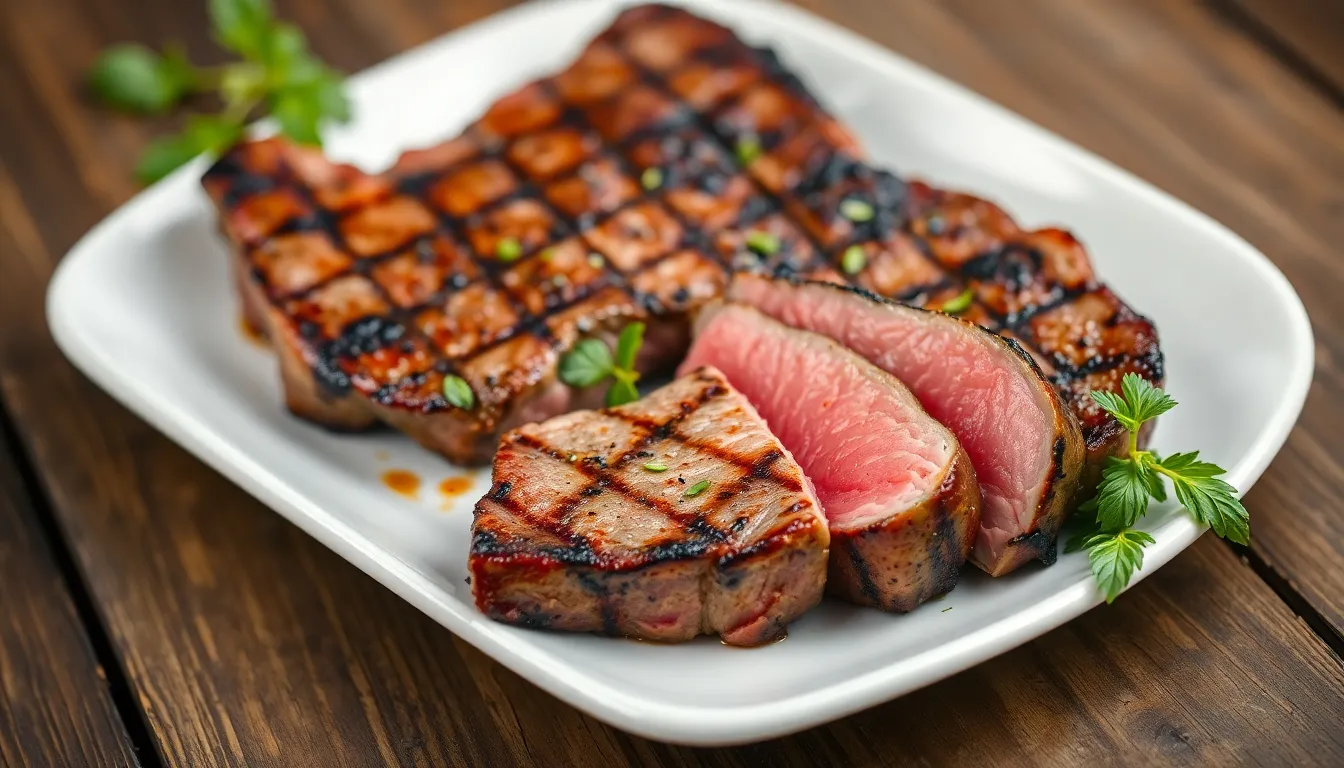When it comes to steak, it’s not just about the sizzle and the savory aroma wafting through the air. The question on everyone’s mind is: how many calories are lurking in that juicy cut? While steak lovers might argue that the taste is worth its weight in calories, understanding the nutritional value can help make informed choices without sacrificing flavor.
Table of Contents
ToggleOverview of Steak Varieties
Different steak varieties offer unique flavors and nutritional profiles. Understanding these can aid in making informed choices regarding calorie content.
Lean Cuts
Lean cuts of steak provide lower fat content and fewer calories. Options like sirloin, filet mignon, and flank steak are excellent examples. Sirloin contains around 200 calories per 3-ounce serving. Filet mignon typically offers about 250 calories for the same portion size. Flank steak, while flavorful, also maintains lower calories, averaging nearly 200 calories per serving. Choosing lean cuts assists in maintaining overall dietary balance while still enjoying the taste of beef.
Fatty Cuts
Fatty cuts of steak deliver richer flavors and higher calorie counts. Ribeye, T-bone, and porterhouse are popular varieties in this category. Ribeye features approximately 350 calories per 3-ounce serving, thanks to its marbling. T-bone contains around 360 calories for the same portion size, making it a hearty choice. Porterhouse often reaches similar levels, providing about 350 calories. Enjoying these cuts can enhance meals, but those seeking calorie control should consider portion sizes.
Factors Influencing Caloric Content

Several factors influence the caloric content of steak. Variations in cooking methods and portion sizes can significantly affect overall calorie counts for different steak cuts.
Cooking Method
Cooking methods play a crucial role in determining the caloric content of steak. Grilling or broiling can produce lower-calorie beef, as excess fat drips away during cooking. Frying or cooking with added oils and fats increases calorie counts. For example, a grilled ribeye typically contains around 350 calories per 3-ounce serving, while a fried ribeye may exceed 400 calories due to added oil. Steaks that are slow-cooked or braised may also absorb extra fat from cooking liquids, further contributing to higher calorie totals.
Portion Size
Portion sizes directly impact the calorie count consumed. A standard serving size for steak is typically 3 ounces. Larger portions naturally result in more calories. For instance, a 6-ounce filet mignon holds around 450 calories, while a smaller 2-ounce portion might have approximately 150 calories. Understanding how serving sizes contribute to overall caloric intake can help in making balanced dietary choices. Adjusting portion sizes allows for enjoyment of steak without overindulging in calories.
Nutritional Breakdown of Steak
Steak provides essential nutrients, primarily protein and fat composition, which contribute to its overall calorie profile. Understanding these components helps individuals navigate their dietary choices.
Protein Content
Protein represents a significant portion of steak’s nutritional value. For instance, a 3-ounce serving of sirloin contains approximately 23 grams of protein. This amount supports muscle growth and repair. Lean cuts like flank steak or filet mignon offer similar protein levels, making them ideal choices for those focused on muscle maintenance. Dietary protein, such as that found in steak, contributes to feelings of satiety, helping control overall calorie intake. Emphasizing high-protein options can assist individuals in reaching their fitness and health goals.
Fat Content
Fat content varies among different steak cuts, affecting calorie counts. Ribeye steak, for instance, has about 28 grams of fat per 3-ounce serving, contributing to its robust flavor yet higher calorie content of around 350 calories. Conversely, leaner cuts, such as sirloin, contain about 10 grams of fat with a reduced calorie count of approximately 200 calories. Notably, the type of fat in steak includes both saturated and monounsaturated fats. Consuming moderate amounts of fats from lean cuts can fit into a balanced diet while enjoying steak’s rich taste.
Comparing Steak with Other Proteins
Steak’s calorie content varies widely when compared to other popular protein sources like chicken and fish.
Chicken
Chicken, particularly skinless breast, is often viewed as a leaner option. A 3-ounce serving of grilled chicken breast has about 140 calories. It provides approximately 26 grams of protein, promoting muscle growth and repair. This lean meat contains only about 3 grams of fat, making it a favorable choice for those watching their calorie intake. Unlike fatty cuts of steak, chicken offers a low-calorie alternative with substantial protein benefits.
Fish
Fish also presents a nutritious comparison, especially varieties like salmon and tuna. A 3-ounce serving of salmon typically contains around 206 calories, accompanied by approximately 22 grams of protein. Fat content varies, with salmon holding about 13 grams due to its healthy omega-3 fatty acids. In contrast, lighter fish options such as cod deliver around 70 calories per 3-ounce serving, offering a lean source of protein with just about 1 gram of fat. Therefore, choices among fish can cater to different dietary preferences and calorie goals.
Steak can be a delicious addition to any diet when consumed mindfully. By understanding the calorie content and nutritional value of different cuts, individuals can enjoy steak while maintaining their health goals. Lean cuts like sirloin and flank steak offer lower calorie options without sacrificing protein intake.
Cooking methods also play a crucial role in determining calorie counts. Grilling or broiling steak can help reduce excess fat and calories. Ultimately, making informed choices about portion sizes and cuts can lead to a satisfying and nutritious eating experience. Enjoying steak in moderation allows for a balance of flavor and health.

